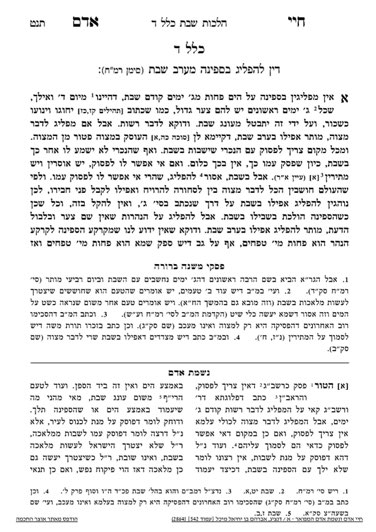We are continuing in siman 1, discussing the ideas introduced by the Chayei Adam regarding techum. The third point we mentioned is that techum does not apply on a Torah level when traveling on a river. The fourth point was that there is a safeik whether techum applies 10 tefachim above ground, and that we measure this height from the bottom of the riverbed.
We need to discuss whether the techum is measured to the bottom of the boat, or to where people sit on the boat. Sea-going vessels never come within 10 tefachim of the sea floor, but sometimes one can be within 10 tefachim if they are on a small boat in a shallow river. Even in those scenarios, unless a person is traveling on a raft, the person themselves will likely be above 10 tefachim.
It is a machlokes how we measure this height. The standard assumption is that we measure from the bottom of the boat. However, there is an opinion that if the bottom of the boat is narrow and unusable for people, one measures from where people sit. The Chayei Adam does not want to rely on this opinion; however, the Mishnah Berurah writes that one can rely on this opinion in a case of necessity.
We can now answer one of our original questions, which was how is it ever possible for a person to be on a boat over Shabbos (even if they boarded before Wednesday night), because they will likely travel out of their techum on Shabbos itself. The answer is that since the person on the boat is always traveling above 10 tefachim, it is a safeik whether techum applies, and since travel on water is derabanan, we can be lenient. One can apply this leniency to shallow water as well, as long as it is still unclear whether they are above or below 10 tefachim.
If a person knows with certainty that they are below 10 tefachim, they would be bound to the halachos of techum from the point at which they are within 10 tefachim. If the bottom of the boat is below 10 tefachim but the area of the boat used by people is above 10 tefachim, in a case of necessity one can be lenient and not follow the halachos of techum.
If one wishes to travel by train over Shabbos (i.e., boarding before Shabbos and alighting after Shabbos), although the chair they will be sitting on is above 10 tefachim, they are traveling on land. Therefore, even though it is above 10 tefachim, so we have a safeik as to whether the halachos of techum apply, the safeik is a safeik deoraysa, so one must be machmir and cannot travel more than 12 mil. Additionally, the bottom of the train is almost certainly within 10 tefachim below ground, so there is more reason to be machmir. Therefore, one cannot travel more than 12 mil on a train, or any other moving vehicle, over Shabbos.
We need to discuss the modern equivalents of the shiurim we have given for techum. It is well known that there are multiple opinions regarding the size of an amah. The three most well-known opinions are of Rav Avraham Chaim Naeh, the Chazon Ish, and Rav Moshe. Rav Naeh wrote many well-known seforim regarding calculating different shiurim. His primary goal was to justify the standard shiurim which were used in Yerushalayim at the time, and as a response to the Chazon Ish, who felt the Yerushalayim shiurim were incorrect. We will also discuss the shiurim given by Rav Moshe Feinstein.
Summary
- There are two shiurim for techum. The smaller one, of 2000 amos beyond the city, is derabanan. The larger one, of 12 mil (3 parsa), is assumed to be deoraysa.
- It is a safeik whether the halachos of techum apply 10 tefachim above ground.
- The concept of techum does not apply to a river mideoraysa. Therefore, when traveling on a boat which is more than 10 tefachim above the riverbed, one can be lenient and assume the halachos of techum do not apply.
- The 10 tefachim are measured from the riverbed to the bottom of the boat. In cases of necessity, one can measure to where people sit.
- On the other hand, techum applies mideoraysa when traveling on land. Therefore, when traveling on a train, even if the seats are above 10 tefachim, one must be machmir and assume the halachos of techum apply.



